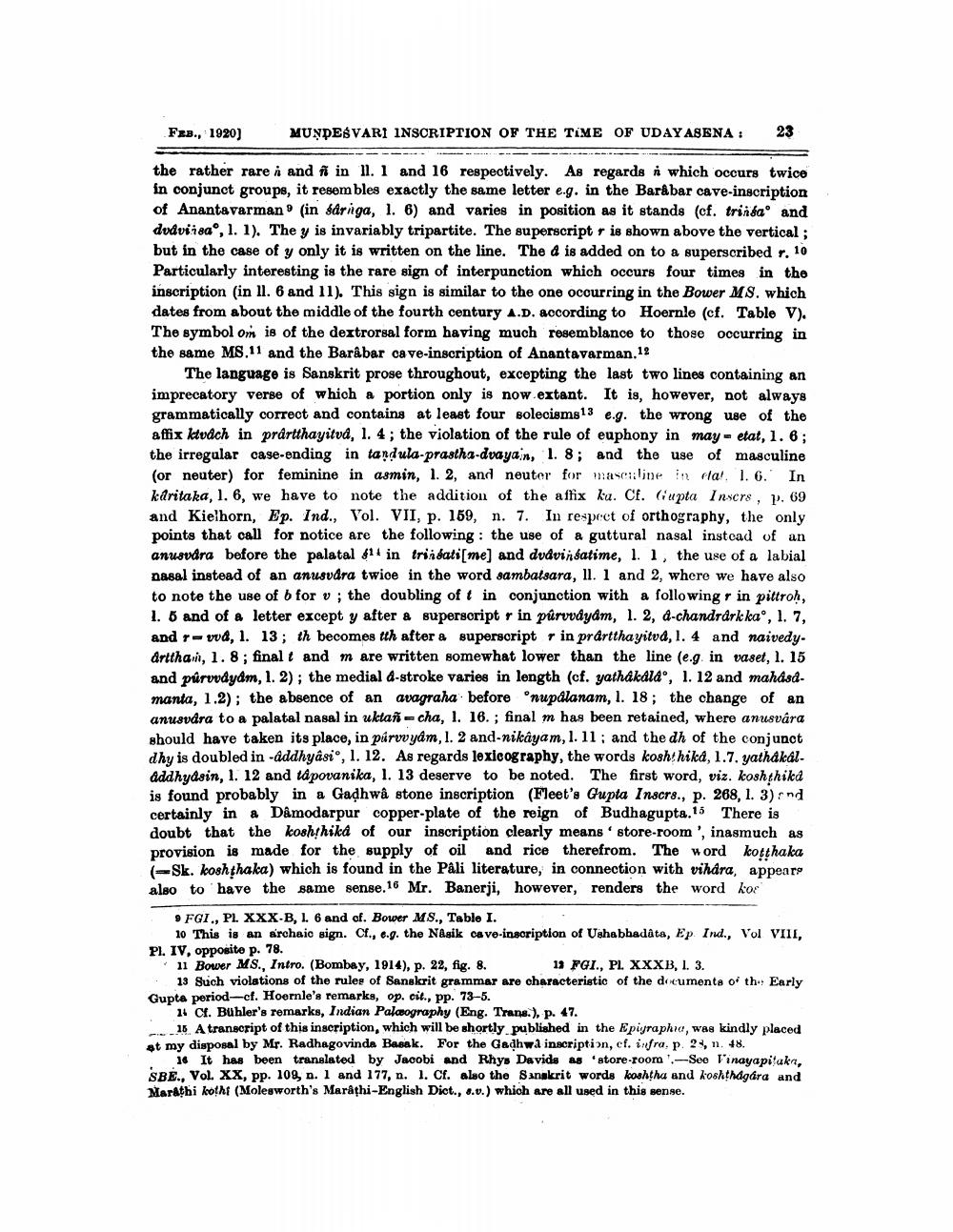________________
Fz3., 1920)
MUNDESVARI INSCRIPTION OF THE TIME OF UDAY ASENA :
23
the rather rare i and f in 11. 1 and 16 respectively. As regards i which occurs twice in conjunct groups, it resembles exactly the same letter e.g. in the Barabar cave-inscription of Anantavarman (in sdriga, 1. 6) and varies in position as it stands (cf. trindao and dvdviisa°, 1. 1). The y is invariably tripartite. The superscript is shown above the vertical ; but in the case of y only it is written on the line. The d is added on to a superscribed r. 10 Particularly interesting is the rare sign of interpunction which occurs four times in the inscription in 11. 6 and 11). This sign is similar to the one ocourring in the Bower MS. which dates from about the middle of the fourth century A.D. according to Hoernle (cf. Table V). The symbol om is of the dextrorsal form having much resemblance to those occurring in the same MS.11 and the Barabar cave-inscription of Anantavarman.12
The language is Sanskrit prose throughout, excepting the last two lines containing an imprecatory verse of which a portion only is now extant. It is, however, not always grammatically correct and contains at least four colecisms13 e.g. the wrong use of the affix ktvách in prartthayitva, 1. 4; the violation of the rule of euphony in may-etat, 1.6; the irregular case-ending in tandula-prastha-dvayan, 1. 8; and the use of masculine (or neuter) for feminine in asmin, 1.2, and neuter for masculine in clal. 1. 6. In karitaka, 1. 6, we have to note the addition of the affix ka. Cf. Cupta Insers, P. 69 and Kielhorn, Ep. Ind., Vol. VII, p. 159, n. 7. In respect of orthography, the only points that call for notice are the following: the use of a guttural nasal instead of an anusvára before the palatal 614 in tribati[me) and dvdvinsatime, 1. 1, the use of a labial nasal instead of an anusvåra twice in the word sambatsara, ll. 1 and 2, where we have also to note the use of b for v; the doubling of t in conjunction with a following rin pittroh, 1. 8 and of a letter except y after a superscript r in pûrvvdyam, 1.2, a-chandrårk ka°, 1. 7, and wd, 1. 13; th becomes tth after & superscript r in prartthayitva, 1. 4 and naivedy. artthai. 1.8final t and m are written somewhat lower than the line (e.g in vaset, l. 15 and púrvvdyam, 1.2); the medial a-stroke varies in length (cf. yathakaldo, 1. 12 and mahasamanta, 1.2); the absence of an avagraha before nupalanam, l. 18; the change of an anusvára to a palatal nasal in uklan=cha, 1. 16.; final m has been retained, where anusvara should have taken its place, in púrvuyam, 1.2 and-nikayam, 1.11 ; and the dh of the conjunct dhy is doubled in -addhyâsi°, 1. 12. As regards lexicography, the words koshthika, 1.7. yathakal. addhyasin, 1. 12 and tapovanika, 1. 13 deserve to be noted. The first word, viz. koshthika is found probably in a Gadhwå stone inscription (Fleet's Gupta Inscrs., p. 268, 1. 3) and certainly in a Damodarpur copper-plate of the reign of Budhagupta.15 There is doubt that the koshthika of our inscription clearly means 'store-room', inasmuch as provision is made for the supply of oil and rice therefrom. The word kotthaka ( Sk. koshthaka) which is found in the Pâli literature, in connection with vihara, appears also to have the same sense.16 Mr. Banerji, however, renders the word koe
9FGI., PL. XXX-B, 1. 6 and of. Bower MS., Table I.
10 This is an archaic sign. Cf., e.g. the Násik cave-inscription of Ushabhadâta, Ep. Ind., Vol VIII, PI. IV, opposite p. 78. 11 Bower MS., Intro. (Bombay, 1914), p. 22, fig. 8.
13 FGI., PL. XXXB, 1. 3. 13 Such violations of the rules of Sanskrit grammar are characteristic of the documents of th. Early Gupta period-cf. Hoernle's remarks, op. cit., pp. 73-5.
14 Cf. Buhler's remarks, Indian Palaography (Eng. Trans.), p. 47.
16 A transcript of this inscription, which will be shortly published in the Epiyraphra, was kindly placed at my disposal by Mr. Radhagovinda Basak. For the Gadhwa inscription, cf. infra. p. 23, n. 48.
16 It has been translated by Jacobi and Rhys Davids as 'store room':-See Vinayapitaka, SBĖ., Vol. XX, pp. 109, n. 1 and 177, n. 1. Cf. also the Sanskrit words koshtha and koskthagara and Marathi kothi (Molesworth's Marathi-English Dict., 6.v.) which are all used in this sense.




